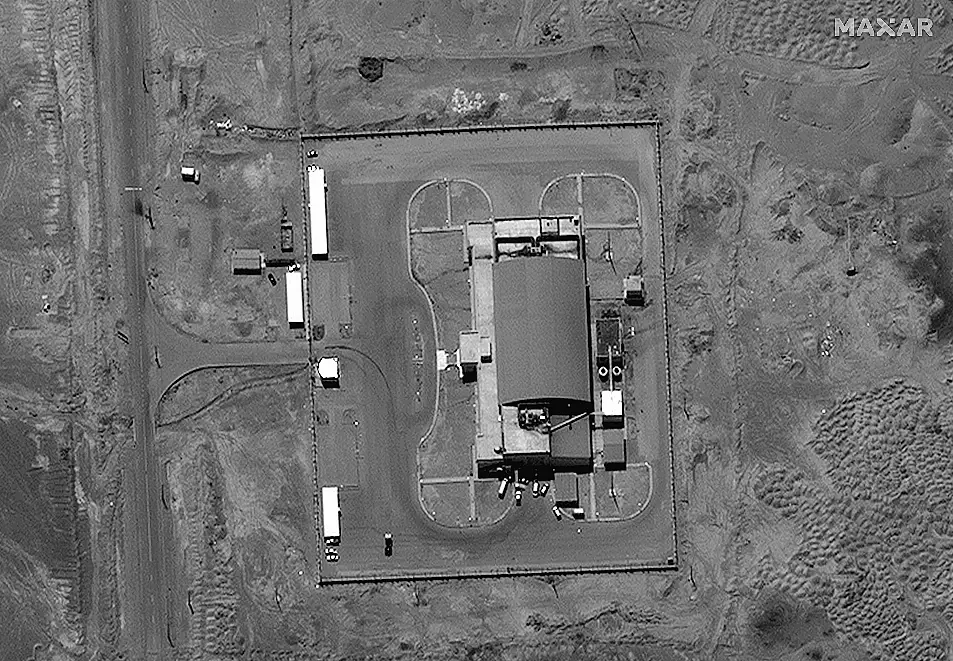Iran has acknowledged it plans two tests for its new solid-fuelled rocket after satellite photos showed preparations at a desert launch pad previously used in the programme.
The launch plans come as tensions remain high over Tehran’s rapidly advancing nuclear programme.
The Islamic Republic will launch its satellite-carrying Zuljanah rocket twice more after conducting a previous launch, the state-run IRNA news agency quoted Defence Ministry spokesman Ahmad Hosseini as saying.
He did not elaborate on a timeframe for the tests, nor did he say when the previous launch occurred.
Each of the Zuljanah’s three stages will be evaluated during the tests, Mr Hosseini said.

Satellite images taken on Tuesday by Maxar Technologies showed preparations at a launch pad at Imam Khomeini Spaceport in the rural province of Semnan, the site of frequent recent failed attempts to put a satellite into orbit.
One set of images showed a rocket on a transporter, preparing to be lifted and put on a launch tower. A later image showed the rocket apparently on the tower.
Though it is not clear when the launch will take place, erecting a rocket typically means a launch is imminent. Nasa fire satellites, which detect flashes of light from space, did not immediately see any activity over the site.
Asked about the preparations, State Department spokesman Ned Price told reporters in Washington that the US urges Iran to de-escalate the situation.
“Iran has consistently chosen to escalate tensions. It is Iran that has consistently chosen to take provocative actions,” Mr Price said.
A Pentagon spokesman, US army major Rob Lodewick, said the American military “will continue to closely monitor Iran’s pursuit of viable space launch technology and how it may relate to advancements in its overall ballistic missile programme”.
He added: “Iranian aggression, to include the demonstrated threat posed by its various missile programmes, continues to be a top concern for our forces in the region.”
Over the past decade, Iran has sent several short-lived satellites into orbit and in 2013 launched a monkey into space.
The programme has seen recent troubles, however. There have been five failed launches in a row for the Simorgh programme, a type of satellite-carrying rocket. A fire at the Imam Khomeini Spaceport in February 2019 also killed three researchers, authorities said at the time.

The launch pad used in Tuesday’s preparations remains scarred from an explosion in August 2019 that even drew the attention of then-president Donald Trump. He later tweeted what appeared to be a classified surveillance image of the launch failure.
Satellite images from February suggested a failed Zuljanah launch earlier this year, though Iran did not acknowledge it.
The successive failures raised suspicion of outside interference in Iran’s programme, something Mr Trump himself hinted at by tweeting at the time that the US “was not involved in the catastrophic accident”.
There has been no evidence offered, however, to show foul play in any of the failures, and space launches remain challenging even for the world’s most successful programmes.
Meanwhile, Iran’s paramilitary Revolutionary Guard in April 2020 revealed its own secret space programme by successfully launching a satellite into orbit. The Guard launched another satellite this March at another site in Semnan, just east of the Iranian capital of Tehran.
The United States has alleged that Iran’s satellite launches defy a UN Security Council resolution and has called on Tehran to undertake no activity related to ballistic missiles capable of delivering nuclear weapons.
The US intelligence community’s 2022 threat assessment, published in March, claims such a satellite launch vehicle “shortens the timeline” to an intercontinental ballistic missile for Iran as it uses “similar technologies”.
Iran, which has long said it does not seek nuclear weapons, previously maintained that its satellite launches and rocket tests do not have a military component.
US intelligence agencies and the International Atomic Energy Agency (IAEA) say Iran abandoned an organised military nuclear programme in 2003.
However, Iran’s likely preparations for a launch come as tensions have been heightened in recent days over Tehran’s nuclear programme. Iran now says it will remove 27 IAEA surveillance cameras from its nuclear sites as it now enriches uranium closer than ever to weapons-grade levels.
Both Iran and the US insist they are willing to re-enter Tehran’s 2015 nuclear deal with world powers, which saw the Islamic Republic drastically curb its enrichment in exchange for the lifting of economic sanctions.
Mr Trump unilaterally withdrew America from the accord in 2018.
Talks in Vienna about reviving the deal have been on a “pause” since March.







